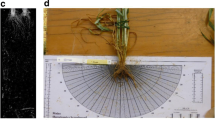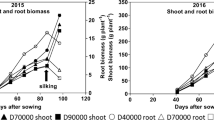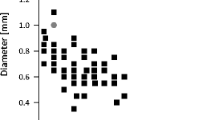Abstract
Root systems of individual crop plants may encounter large variations in mechanical impedance to root penetration. Split-root experiments were conducted to compare the effects of spatial variation in soil strength on the morphological plasticity of wheat and barley roots, and its relationship to shoot growth. Plants of spring barley (Hordeum vulgare cv Prisma) and spring wheat (Triticum aestivum cv Alexandria) were grown for 12 days with their seminal roots divided between two halves of a cylinder packed with sandy loam soil. Three treatment combinations were imposed: loose soil where both halves of the cylinder were packed to 1.1 g cm−3 (penetrometer resistance 0.3 MPa), dense soil where both halves were packed to 1.4 g cm−3 (penetrometer resistance 1 MPa), and a split-root treatment where one half was packed to 1.1 and the other to 1.4 g cm−3. In barley, uniform high soil strength restricted the extension of main seminal root axes more than laterals. In the split-root treatment, the length of laterals and the dry weight of main axes and laterals were increased in the loose soil half and reduced in the dense soil half compared with their respective loose and dense-soil controls. No such compensatory adjustments between main axis and laterals and between individual seminal roots were found in wheat. Variation in soil strength had no effect on the density of lateral roots (number per unit main axis length) in either barley or wheat. The nature and extent of wheat root plasticity in response to variation in soil strength was very different from that in response to changes in N-supply in previous experiments. In spite of the compensatory adjustments in growth between individual seminal roots of barley, the growth of barley shoots, as in wheat, was reduced when part of the root system was in compacted soil.
Similar content being viewed by others
References
Bengough A G and Mullins C E 1990 Mechanical impedance to root growth: a review of experimental techniques and root growth responses. J. Soil Sci. 41, 341–358.
Bennie A T P 1996 Growth and mechanical impedance. In Plant Roots: The Hidden Half. Eds. Y Waisel, A Eshel and U Kafkafi. pp. 453–470. Marcel Dekker Inc., New York, USA.
Bingham I J, Blackwood J M and Stevenson E A 1997 Site, scale and time-course for adjustments in lateral root initiation in wheat following changes in C and N supply. Ann. Bot. 80, 97–106.
Bingham I J, Blackwood J M and Stevenson E A 1998 Relationship between tissue sugar content, phloem import and lateral root initiation in wheat. Physiol. Plant. 103, 107–113.
Cook A, Marriot C A, Seel W and Mullins C E 1996 Effects of soil mechanical impedance on root and shoot growth of Lolium perenne L., Agrostis capillaris and Trofolium repens L. J. Exp. Bot. 47, 1075–1084.
Dickson J W and Campbell D J 1990 Soil and crop responses to zero-traffic and conventional-traffic systems for winter barley in Scotland, 1982–1986. Soil Till. Res. 18, 1–26.
Drew M C 1975 Comparison of the effects of a localized supply of phosphate, nitrate, ammonium and potassium on the growth of the seminal root system, and the shoot, in barley. New Phytol. 75, 479–490.
Gersani M and Sachs T 1992 Developmental correlations between roots in heterogeneous environments. Plant Cell Environ. 15, 463–469.
Goss M J 1977 Effects of mechanical impedance on root growth in barley (Hordeum vulgare L.). I. Effects on elongation and branching of seminal roots. J. Exp. Bot. 28, 96–111.
Hackett C 1972 A method of applying nutrients locally to roots under controlled conditions, and some morphological effects of locally applied nitrate on the branching of wheat roots. Aust. J. Biol. Sci. 25, 1169–1180.
Hunt R 1978 Plant Growth Analysis. Edward Arnold (Publishers) Ltd., London, UK. 67 pp.
Hussain A, Black C R, Taylor I B, Mulholland B J and Roberts J A 1999 Novel approaches for examining the effects of differential soil compaction on xylem sap abscisic acid concentration, stomatal conductance and growth in barley (Hordeum vulgare L.). Plant Cell Environ. 22, 1377–1388.
Marshall T J and Holmes J W 1979 Soil Physics, pp. 270. Cambridge University Press, Cambridge, UK.
Masle J 1992 Genetic variation in the effects of root impedance on growth and transpiration rates of wheat and barley. Aust. J. Plant Physiol. 19, 109–125.
Masle J 1999 Root impedance: sensing, signalling and physiological effects. In Plant Responses to Environmental Stresses From Phytohormones to Genome Reorganization. Ed. H R Lerner. pp. 475–495. Marcel Dekker Inc., New York, USA.
Misra R K and Gibbons A K 1996 Growth and morphology of eucalypt seedling-roots in relation to soil strength arising from compaction. Plant Soil 182, 1–11.
Monatgu K D, Conroy J P and Atwell B J 2001 The position of localized soil compaction determines root and subsequent shoot growth responses. J. Exp. Bot. 52, 2127–2133.
Moss G I, Hall K C and Jackson M B 1988 Ethylene and the responses of roots of maize (Zea mays L.) to physical impedance. New Phytol. 109, 303–311.
Mulholland B J, Black C R, Taylor I B, Roberts J A and Lenton J R 1996 Effect of soil compaction on barley (Hordeum vulgare L.) growth. I. Possible role for ABA as a root-sourced chemical signal. J. Exp. Bot. 47, 539–549.
Mulholland B J, Hussain A, Black C R, Taylor I B and Roberts J A 1999 Does root–sourced ABA have a role in mediating growth and stomatal responses to soil compaction in tomato (Lycopersicon esculentum). Physiol. Plant. 107, 267–276.
Pages L 2000 How to include organ interactions in models of the root system architecture? The concept of endogenous environment. Ann. For. Sci. 57, 535–541.
Robinson D 1994 The response of plants to non-uniform supplies of nutrients. New Phytol. 127, 635–674.
Sarquis J I, Jordan W R and Morgan P W 1991 Ethylene evolution from maize (Zea mays L.) seedling roots and shoots in response to mechanical impedance. Plant Physiol. 96, 1171–1177.
Tardieu F, Zhang J, Katerji N, Bethonod O and Davies W J 1992 Xylem ABA controls the stomatal conductance of field-grown maize subjected to soil compaction or soil drying. Plant Cell Environ. 15, 193–197.
Tennant D 1975 A test of a modified line intersect method of estimating root length. J. Ecol. 63, 995–1001.
Thaler P and Pages L 1999 Why are laterals less affected than main axes by homogeneous unfavourable physical conditions? A model-based hypothesis. Plant Soil 217, 151–157.
Zhang H M and Forde B G 1998 An Arabidopsis MADS box gene that controls nutrient-induced changes in root architecture. Science 279, 407–409.
Author information
Authors and Affiliations
Corresponding author
Rights and permissions
About this article
Cite this article
Bingham, I., Bengough, A. Morphological plasticity of wheat and barley roots in response to spatial variation in soil strength. Plant and Soil 250, 273–282 (2003). https://doi.org/10.1023/A:1022891519039
Issue Date:
DOI: https://doi.org/10.1023/A:1022891519039




